

Law of large numbers. Almost surely. The terms almost certainly (a.c.) and almost always (a.a.) are also used.
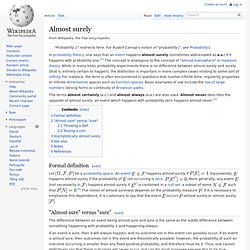
Almost never describes the opposite of almost surely; an event which happens with probability zero happens almost never.[2] Formal definition[edit] Let happens almost surely if . Time travel. Explosively pumped flux compression generator. Voyager Golden Record. Cover of the Voyager Golden Record The Voyager Golden Records are phonograph records which were included aboard both Voyager spacecrafts, which were launched in 1977.
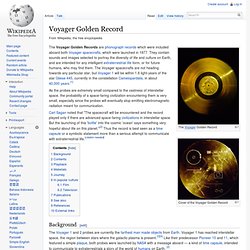
They contain sounds and images selected to portray the diversity of life and culture on Earth, and are intended for any intelligent extraterrestrial life form, or for future humans, who may find them. The Voyager spacecrafts are not heading towards any particular star, but Voyager 1 will be within 1.6 light-years of the star Gliese 445, currently in the constellation Camelopardalis, in about 40,000 years.[1] Voyager Golden Record. Maslow's hierarchy of needs. Maslow's hierarchy of needs, represented as a pyramid with the more basic needs at the bottom[1] Maslow's hierarchy of needs is a theory in psychology proposed by Abraham Maslow in his 1943 paper "A Theory of Human Motivation" in Psychological Review.[2] Maslow subsequently extended the idea to include his observations of humans' innate curiosity.
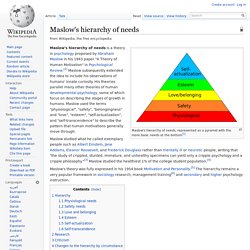
His theories parallel many other theories of human developmental psychology, some of which focus on describing the stages of growth in humans. Maslow used the terms "physiological", "safety", "belongingness" and "love", "esteem", "self-actualization", and "self-transcendence" to describe the pattern that human motivations generally move through. Maslow's theory was fully expressed in his 1954 book Motivation and Personality.[5] The hierarchy remains a very popular framework in sociology research, management training[6] and secondary and higher psychology instruction.
Hierarchy Physiological needs Safety needs Safety and Security needs include: MPTP. MPTP (1-methyl-4-phenyl-1,2,3,6-tetrahydropyridine) is a neurotoxin precursor to MPP+, which causes permanent symptoms of Parkinson's disease by destroying dopaminergic neurons in the substantia nigra of the brain.

It has been used to study disease models in various animal studies. While MPTP itself has no psychoactive effects, the compound may be accidentally produced during the manufacture of MPPP, a synthetic opioid drug with effects similar to those of morphine and pethidine (meperidine). The Parkinson-inducing effects of MPTP were first discovered following accidental ingestion as a result of contaminated MPPP.
Toxicity[edit] Injection of MPTP causes rapid onset of Parkinsonism, hence users of MPPP contaminated with MPTP will develop these symptoms. MPTP itself is not toxic, and as a lipophilic compound can cross the blood–brain barrier. OODA loop. Diagram of a decision cycle known as the Boyd cycle, or the OODA loop Overview[edit] The OODA loop has become an important concept in litigation,[1] business[2] and military strategy.
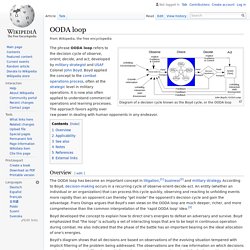
According to Boyd, decision-making occurs in a recurring cycle of observe-orient-decide-act. An entity (whether an individual or an organization) that can process this cycle quickly, observing and reacting to unfolding events more rapidly than an opponent can thereby "get inside" the opponent's decision cycle and gain the advantage. Frans Osinga argues that Boyd's own views on the OODA loop are much deeper, richer, and more comprehensive than the common interpretation of the 'rapid OODA loop' idea.[3] Boyd developed the concept to explain how to direct one's energies to defeat an adversary and survive.
Ig Nobel Prize. The Ig Nobel Prizes are a parody of the Nobel Prizes and are given each year in early October for ten unusual or trivial achievements in scientific research.

The stated aim of the prizes is to "honor achievements that first make people laugh, and then make them think. " The awards are sometimes veiled criticism (or gentle satire), but are also used to point out that even the most absurd-sounding avenues of research can yield useful knowledge. Organized by the scientific humor magazine Annals of Improbable Research (AIR), they are presented by a group that includes Nobel Laureates at a ceremony at Harvard University's Sanders Theater, and they are followed by a set of public lectures by the winners at MIT.[1] The name is a play on the words ignoble ("characterized by baseness, lowness, or meanness") and the Nobel Prize. German tank problem. During World War II, production of German tanks such as the Panther was accurately estimated by Allied intelligence using statistical methods In the statistical theory of estimation, the problem of estimating the maximum of a discrete uniform distribution from sampling without replacement is known in English as the German tank problem, due to its application in World War II to the estimation of the number of German tanks.
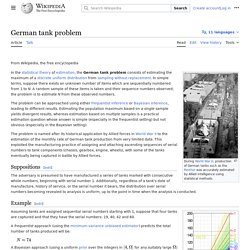
This analysis shows the approach that was used and illustrates the difference between frequentist inference and Bayesian inference. Estimating the population maximum based on a single sample yields divergent results, while the estimation based on multiple samples is an instructive practical estimation question whose answer is simple but not obvious. Example[edit] Suppose an intelligence officer has spotted k = 4 tanks with serial numbers, 2, 6, 7, and 14, with the maximal observed serial number m = 14.